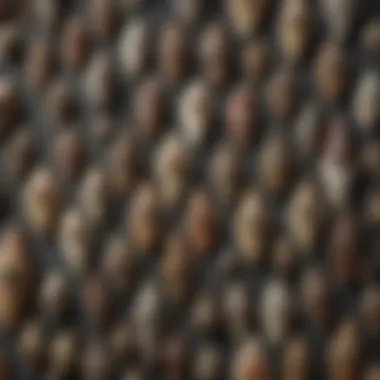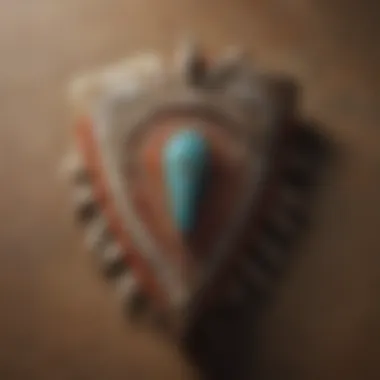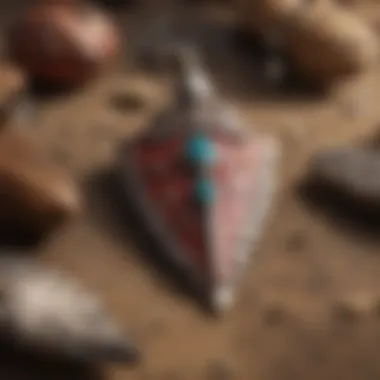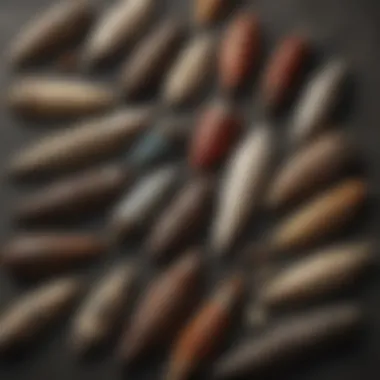Exploring the Authentic World of Indian Arrowheads for Sale: A Collector's Guide


Rock and Fossil Identification
Collecting Tips and Techniques
For rock and fossil collectors seeking authentic Indian arrowheads, adopting best practices for collecting is essential. Locating prime collecting sites involves research into historical Native American territories or archaeological sites. Safely extracting specimens requires precision and patience, utilizing tools like brushes and small trowels to avoid damaging delicate artifacts.
Preservation and Display
Preserving rocks and fossils, including Indian arrowheads, necessitates implementing proper techniques to prevent deterioration. Storage methods such as acid-free containers and silica gel packets help maintain the integrity of these artifacts. Creative display ideas, such as shadow boxes or themed arrangements, can showcase these culturally rich items while ensuring their protection.
Geological Insights
Delving into the geological aspects of Indian arrowheads involves understanding the geological formations and processes that shaped the materials used. The historical significance of rocks and fossils in Native American cultures adds depth to the appreciation of these artifacts. Notable discoveries in the field continue to contribute valuable insights into the intersection of geology and cultural heritage.
Introduction
In the realm of antiquities and relics, Indian arrowheads stand as intriguing cultural markers, resonating with the essence of Native American history and craftsmanship. This article embarks on a journey delving into the captivating world of authentic Indian arrowheads for sale, a realm where enthusiasts and collectors alike seek to uncover ancient artifacts that not only tell stories of the past but also hold deep cultural significance. From arrowheads crafted with precision and skill to those that carry symbolic motifs reflective of tribal narratives, these artifacts serve as portals to understanding the rich tapestry of Native American cultures. Through this comprehensive guide, readers will traverse through the historical significance of Indian arrowheads, unravel where these treasures can be found, and discern essential factors to consider when stepping into the realm of acquiring these culturally enriched pieces.
Within the encompassing literature dedicated to antiquities, Indian arrowheads hold a unique position, offering not just items for collection but windows into the intricate craftsmanship and symbolism ingrained within each piece. As the foundation of this guide, the Introduction sets the stage by shedding light on the allure of authentic Indian arrowheads, encapsulating the essence of these artifacts and stirring curiosity for what lies ahead in the exploration of their origins, cultural importance, and appreciation as works of artistry.
History of Indian Arrowheads
The history of Indian arrowheads holds immense significance within the context of exploring authentic artifacts. Indian arrowheads are not merely objects but a direct link to the past, carrying stories of ancient indigenous cultures. Understanding their history provides invaluable insights into the technological advancements, hunting practices, and the artistic expressions of Native American tribes. Each arrowhead serves as a tangible connection to a bygone era, reflecting the ingenuity and skills of its creators.
Origins and Significance
The origins of Indian arrowheads trace back thousands of years, symbolizing the craftsmanship and resourcefulness of Native American communities. These artifacts were crafted meticulously from various materials such as flint, obsidian, and chert, showcasing the diverse geological knowledge of ancient artisans. The significance of arrowheads lies not only in their functionality as hunting tools but also in their symbolic importance, signifying protection, honor, and spiritual beliefs within tribal societies.


Cultural Importance
The cultural importance of Indian arrowheads cannot be overstated, as they represent more than just tools. These artifacts embody a way of life, a connection to the land, and a deep reverence for nature among indigenous groups. Arrowheads were intricately linked to rituals, ceremonies, and traditional practices, reflecting the ancient wisdom and resilience of Native American cultures. Owning a genuine Indian arrowhead is not just owning an object but holding a piece of history and cultural heritage passed down through generations.
Evolution of Arrowhead Styles
The evolution of arrowhead styles encapsulates the adaptive nature of Native American societies over time. As tribes migrated, interacted with other groups, and encountered new resources, the styles and designs of arrowheads underwent transformation. From the Clovis points of the Paleo-Indian period to the delicate stemmed points of the Archaic period, each style reflects the environmental influences, trade networks, and technological innovations prevalent during specific eras. Studying the evolution of arrowhead styles not only showcases the diversity of Native American craftsmanship but also sheds light on the cultural exchanges and historical shifts that shaped ancient societies.
Where to Find Authentic Indian Arrowheads
In the expansive world of authentic Indian arrowheads, knowing where to find these coveted artifacts is crucial for collectors and enthusiasts alike. This section explores the significance of locating authentic Indian arrowheads, delving into specific elements, benefits, and considerations that play a pivotal role in the acquisition process.
Archaeological Sites
Discovering authentic Indian arrowheads at archaeological sites offers a profound connection to history and culture. These sites hold immense value for enthusiasts seeking direct contact with ancient artifacts. Understanding the intricate details of each arrowhead found at these sites provides a unique insight into the craftsmanship and historical significance of these items. Archaeological sites serve as portals to the past, allowing collectors to unearth treasures that embody the rich heritage of Native American civilizations.
Artifacts Shows and Auctions
Artifacts shows and auctions represent prime opportunities for acquiring authentic Indian arrowheads. These events not only provide a platform for showcasing a diverse range of artifacts but also offer a chance to interact with experts and fellow enthusiasts. Attending artifact shows grants collectors access to a curated selection of arrowheads, enabling them to expand their collections with unique pieces. Auctions, on the other hand, present a dynamic environment where enthusiasts can engage in spirited bidding wars to secure prized arrowheads that hold historical and cultural significance.
Online Platforms
In the digital age, online platforms have revolutionized the accessibility of authentic Indian arrowheads. These platforms serve as virtual marketplaces where collectors can browse through a plethora of arrowheads from various regions and time periods. Online platforms not only provide convenience in purchasing but also offer a wide selection catering to different interests and budgets. Engaging with online communities and forums dedicated to arrowhead collecting further enhances the buying experience, allowing enthusiasts to learn from fellow collectors and experts while expanding their knowledge and collection.
Factors to Consider When Purchasing
When delving into the world of authentic Indian arrowheads for sale, it is paramount to understand the key factors that should be carefully considered before making a purchase. The topic of factors to consider when purchasing not only adds depth to this article but also serves as a crucial guide for collectors and enthusiasts looking to acquire these culturally significant artifacts. By shedding light on specific elements, benefits, and essential considerations, individuals can make informed decisions about investing in Indian arrowheads.


Authenticity
When looking to purchase authentic Indian arrowheads, the aspect of authenticity holds paramount importance. Evaluating the genuineness of an arrowhead involves considering various factors such as material composition, craftsmanship style, and potential age of the artifact. Collectors should pay close attention to the presence of patina, signs of wear consistent with age, and any accompanying documentation that confirms the item's provenance.
Condition and Quality
The condition and quality of an Indian arrowhead play a significant role in determining its overall value and desirability. Assessing factors like sharpness, intactness of the arrowhead's tip, and any damage or restoration work are crucial in gauging its condition. Moreover, the quality of craftsmanship, precision in shaping, and the presence of intricate details can provide insights into the skill and artistry of the arrowhead's creator.
Provenance and Documentation
Understanding the provenance of an Indian arrowhead is essential for establishing its authenticity and historical significance. Documentation that details the artifact's origin, previous ownership history, and any associated cultural context can greatly enhance its value. Validating the provenance through reputable sources and research adds credibility to the arrowhead's narrative and enriches its overall story.
Legal Considerations
Before making a purchase, collectors must navigate legal considerations surrounding the acquisition of Indian arrowheads. Depending on the region or country, regulations regarding the sale and ownership of archaeological artifacts may vary. It is crucial to adhere to legal requirements, acquire necessary permits or licenses, and ensure compliance with laws pertaining to the trade of cultural heritage items.
Appreciating the Artistry of Indian Arrowheads
In the realm of authentic Indian arrowheads, appreciating the artistry embedded within these artifacts is a pivotal aspect that adds a layer of depth to their value and allure. The craftsmanship and intricate designs of these arrowheads speak volumes about the skill, creativity, and cultural significance of the Native American tribes that created them. By focusing on this topic in our exploration, we aim to highlight not just the physical beauty of these objects but also their historical and cultural importance.
Design and Craftsmanship
Delving deeper into the design and craftsmanship of Indian arrowheads unveils a world of precision and artistry. Each arrowhead reflects the unique style and technique of the tribe that crafted it, showcasing a blend of functionality and aesthetics. The meticulous chiseling, shaping, and detailing of these artifacts demonstrate the unparalleled skills of the craftsmen who worked with rudimentary tools to create masterpieces that have withstood the test of time. Understanding the design intricacies and the materials used in crafting these arrowheads provides valuable insights into the technological advancements and artistic sensibilities of ancient Native American communities.
Symbolism and Cultural Motifs
Unraveling the symbolism and cultural motifs present in Indian arrowheads unveils a rich tapestry of beliefs, traditions, and stories deeply embedded within these artifacts. Each symbol etched or carved onto an arrowhead carries profound meanings related to hunting practices, spiritual rituals, or tribal identities. Exploring the underlying symbolism allows enthusiasts to appreciate the deeper connections these arrowheads hold with the Native American way of life, offering a window into the spiritual and cultural dimensions of the tribes that created them. By deciphering these motifs, collectors can gain a deeper appreciation for the diverse cultural heritage reflected in these seemingly simple yet symbolically rich artifacts.


Comparative Analysis
Conducting a comparative analysis of Indian arrowheads from different tribes and regions provides a fascinating glimpse into the diversity and evolution of arrowhead styles over time. Contrasting the shapes, sizes, materials, and designs of arrowheads allows collectors to discern unique characteristics that differentiate artifacts from various cultures. By exploring these differences, enthusiasts can trace the migratory patterns of tribes, technological innovations, and cultural exchanges that influenced the development of arrowhead styles. Comparative analysis not only enriches one's understanding of Indian arrowheads but also sheds light on the interconnectedness of Native American communities through shared artistic practices and traditions.
Preserving and Displaying Indian Arrowheads
Storage Methods
When it comes to storing Indian arrowheads, proper storage methods are essential to prevent damage and deterioration. One key consideration is to store them in a controlled environment away from direct sunlight, extreme temperatures, and moisture. Utilizing archival-quality storage materials such as acid-free paper, foam, or boxes can help prevent corrosion and physical harm. Additionally, arranging the arrowheads in individual compartments or trays can minimize contact and friction, preserving their intricate details and craftsmanship over time.
Display Options
The method of displaying Indian arrowheads is an art form in itself, allowing collectors to showcase these artifacts while also protecting them from elements that could lead to deterioration. Display cases with UV-protected glass or acrylic shields can help reduce light exposure and dust accumulation while providing a visually appealing backdrop for the arrowheads. Consider incorporating themed displays or arranging the arrowheads based on stylistic characteristics to add dimension and storytelling to the exhibit. Furthermore, rotating displays periodically can prevent prolonged exposure to light and ensure even preservation.
Maintenance and Care
Maintaining Indian arrowheads involves regular inspections and gentle cleaning to safeguard their condition and aesthetics. Using a soft brush or cloth, gently remove dust or debris that can accumulate over time, being careful not to apply excessive pressure that may damage fragile edges or surfaces. Avoid using chemical cleaners or water unless recommended by conservation experts, as improper cleaning methods can harm the arrowheads' material composition. By maintaining a consistent care routine and seeking professional advice when needed, collectors can prolong the lifespan and beauty of these cultural treasures.
Conclusion
Significance of the Topic
The magnificence of Indian arrowheads lies not only in their physical form but in the stories they carry from ancient Native American cultures. By delving into the world of authentic Indian arrowheads, collectors and enthusiasts are granted a glimpse into a bygone era, connecting with the heritage and craftsmanship of indigenous peoples. The conclusion allows one to reflect on the deep-rooted cultural importance and historical legacy of these artifacts, encouraging a newfound appreciation for the artistry and symbolism encapsulated within each piece.
Relevance to the Article
Within the context of this article, the conclusion plays a vital role in summarizing the key takeaways and insights provided throughout the guide. It underscores the importance of understanding factors such as authenticity, condition, and provenance when acquiring Indian arrowheads, emphasizing the necessity of thorough research and due diligence in building a meaningful collection. Furthermore, the conclusion reinforces the significance of preserving and displaying these artifacts with care and reverence, ensuring their longevity and continued cultural relevance.
Impact and Reflection
By concluding the discourse on authentic Indian arrowheads for sale, readers are encouraged to contemplate the broader implications of owning and appreciating such historical treasures. The section prompts introspection on the responsibilities that come with collecting ancient artifacts, urging individuals to approach acquisition with sensitivity and respect for the cultures from which these items originate. Ultimately, the conclusion serves as a call to action for enthusiasts to not only admire the beauty of Indian arrowheads but also to safeguard and honor their cultural heritage for future generations to appreciate.
In essence, the conclusion of this article serves as a closing statement that resonates with the core themes of historical awareness, cultural preservation, and the enduring legacy of authentic Indian arrowheads.







